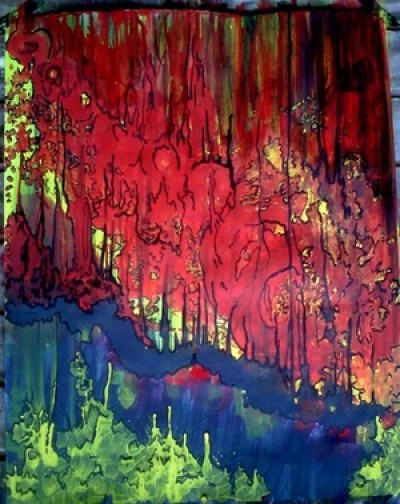Fear not, all you readers who think the younger generations want only to play games at museums, or take pictures of the art with their cell phones, or socialize in the galleries.
The teen curators at the Albright-Knox Art Gallery, which I wrote about here last year, are proving that they are more interested in "old-fashioned" museums than some people think.
Every year, you'll remember, the AK's teen curators curate an exhibition from works submitted by area teenagers. as last year, more than 400 submissions, in all media, were considered. (That's a work by Megan Krug at left)
Here's the "surprising" part. This year's exhibition, which opened May 6th and runs through July 3, is called "raw," and according to the press release has this theme:
...citing the widespread influence of technology and the difficulty in imagining the modern era without it...they have selected works that delve into the realm of introspection, and that represent a specific emotional state, incorporating motifs that are both organic and visceral. The works, and the messages they evoke, correspond to an era before mass communication. The result is an exhibition with an atmosphere free of the pollution of technology--a sort of sanctuary from the mechanics of everyday life. The works reject the recognizable and commercial: each is, in itself, raw.
Gosh: "pollution" and "sanctuary"? Strong words. Do today's teens see museums as sanctuaries, as many adults do? I asked the Albright-Knox teen curators that, and I asked why they chose this theme.
The theme for our exhibition was selected to give our viewers an atmosphere free of technology. The purpose of our exhibition was to bring this idea that nature is the foreground and beginning to everything, to showcase the interaction of nature in our everyday lives.
From Future Curator Chelsea Butkowski:
The future curators chose this theme because many of the pieces that we received deal with a common idea, the organic core inside all humans, something that many of us forget in this era of computers and technology. We wanted to honor the earthy colors and natural forms that many of the submitted works display. The word, "raw", is meant to remind those who attend the exhibiton of raw materials and nature. We tried to achieve a balance between the natural world and the technological one. It's also a bit ironic because most artworks require some sort of munipulation of raw materials to achieve the artist's desired affect.
To my question, "should museums be sancutaries (most of the time)?" she answered:
I think so. A museum is a place to appreciate. The most important conversation to be had there is within a person's own mind. By using a museum the right way, people can learn volumes about themselves in a calm enviornment. That is what a sanctuary is all about. Our lives are too encompassed by habit; a lot of people are thirsty for the challenge that a museum presents. I am sure that raw presents this challenge.
From Future Curator Leigh Ann Gantz:
..our theme was chosen in an attempt to coordinate all the works we wanted to include in our show. That being said, it wasn't done in a patchy attempt to connect unrelated items. it really was something that took us weeks to come up with because we were determined to do justice to the pieces we loved, and simultaneously connect with the community. It really wasn't easy. but in the end, we feel the adjective we chose to describe the whole thing is truly fitting. "Raw" is the most honest way to refer to all these things, not only as individual pieces but also as a show, in its entirety, as objects that work together and communicate with each other through the use of the theme. Hopefully the audience sees it that way.
To my "sanctuary" question:
I don't think this statement always applies to art museums; I believe it can, and often does, but doesn't necessarily have to. It is often the case that art applies the mechanics of every day life, to make a statement, and the idea of removing one's self from the real world in order to create is unrealistic to many artists. At times, art museums reflect this view, and the "sanctuary" idea is lost. I don't think that's a bad thing, though. I think the idea of twisting the world of every day things into art is brilliance, it's just not what we chose to do here. There are lot of ways to present art. This way just happens to be ours. We're very proud of it.
There's hope.
[ Read more from Judith at Real Clear Arts Blog ]

